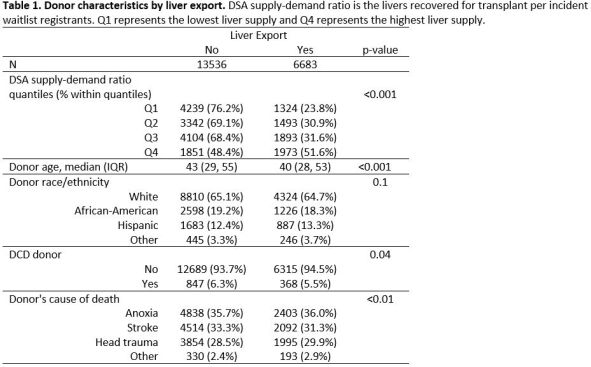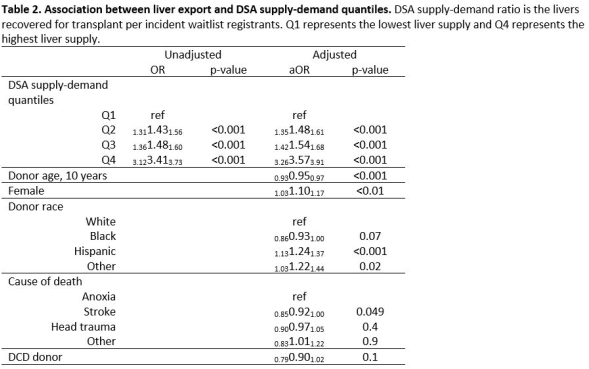DSA-Level Liver Availability and Liver Utilization
The JHU, Baltimore.
Meeting: 2018 American Transplant Congress
Abstract number: A289
Keywords: Liver, Liver transplantation
Session Information
Session Name: Poster Session A: Liver: MELD, Allocation and Donor Issues (DCD/ECD)
Session Type: Poster Session
Date: Saturday, June 2, 2018
Session Time: 5:30pm-7:30pm
 Presentation Time: 5:30pm-7:30pm
Presentation Time: 5:30pm-7:30pm
Location: Hall 4EF
DSA-level geographic disparity in access to deceased-donor liver transplantation is well described. However, understanding the relationship between liver availability in a DSA and exportation of recovered livers within that DSA is critical for characterizing the impacts of geographic inequity.
METHODS: Using SRTR data 2013-2017, we identified 20,219 adult deceased-donor livers that were eventually used for transplant. Liver supply-demand ratio (ratio of recovered livers to incident waitlist registrants) for each DSA was classified in quartiles (Q1-Q4: lowest-highest). We calculated the association between liver export (liver transplanted outside of the DSA from which it was recovered) and liver supply-demand ratio quartiles using logistic regression, adjusting for donor age, gender, race, cause of death, and DCD/DBD status.
RESULTS: Overall 33.05% (6,683) of transplanted livers were exported. The proportion exported ranged from 23.8% in DSAs with the lowest liver supply to 51.6% in DSAs with the highest liver supply (Table 1). After adjustment, compared to Q1, odds of liver export was 48% (aOR=1.351.481.61, p<0.001) higher in Q2, 54% (aOR=1.421.541.68, p<0.001) higher in Q3, and 3.6-folds higher in Q4 (aOR=3.263.573.91, p<0.001) (Table 2).
CONCLUSION: DSAs with a large number of liver waitlist registrants and few available deceased-donor livers utilize a higher proportion of locally offered livers.
CITATION INFORMATION: Zhou S., Bowring M., Massie A., Gentry S., Segev D. DSA-Level Liver Availability and Liver Utilization Am J Transplant. 2017;17 (suppl 3).
To cite this abstract in AMA style:
Zhou S, Bowring M, Massie A, Gentry S, Segev D. DSA-Level Liver Availability and Liver Utilization [abstract]. https://atcmeetingabstracts.com/abstract/dsa-level-liver-availability-and-liver-utilization/. Accessed December 28, 2025.« Back to 2018 American Transplant Congress


